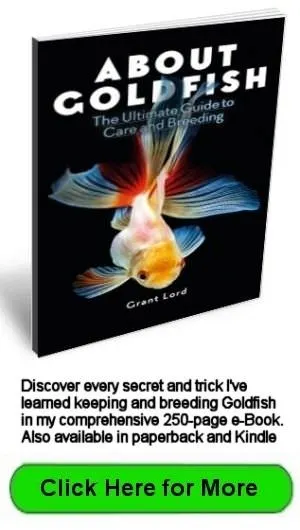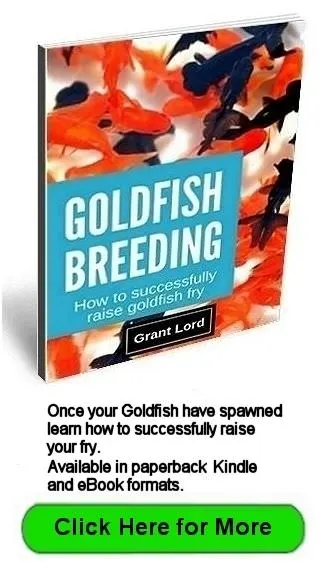- Home
- Raising Goldfish Fry (babies)
- Feeding Goldfish Fry
- Daphnia Cultures
Daphnia Cultures
Daphnia tend to have a population explosion when conditions are good, then die off as the food supply runs out.
Daphnia cultures suddenly dying off don't help the goldfish enthusiast who wants to maintain a supply of high quality live food year round.
Apart from feeding small fry in spring, it is useful to have daphnia on hand throughout the year so you can:
- Start your cultures in early spring without first having to find a pest free source
- Encourage reluctant Goldfish to spawn
- Use them as a live food source for juveniles you are growing up
- Give Goldfish adults a boost in autumn in preparation for next year’s spawning.
Daphnia Culture Method
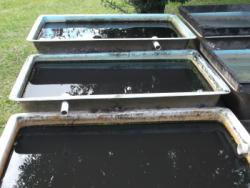 80 gallon fiberglass daphnia ponds
80 gallon fiberglass daphnia pondsWhen a culture has peaked feeding on green water, and the water is becoming clear, it will need to be fed otherwise it will die. There can still be some die back even if you do feed it, but the culture seems to re-establish itself at a more sustainable level.
This level is probably based on the amount of food they are receiving and oxygen levels.
I have my daphnia cultures in 80 gallon fiberglass ponds. You can grow daphnia in anything that holds water and is suitable for fish, but you will need to work out how much you want. Do you just want to maintain a seed culture for starting cultures in spring, or for feeding larger fish over the warmer months?
If you only have a few fish, I would start with a 20 gallon container and work upwards if necessary. My 80 gallon cultures produce huge amounts of daphnia. One would provide enough daphnia to feed 10 two inch (body length) goldfish daily.
If you use small containers, you will need to protect the culture from sudden temperature changes, as you would for fish.
Feeding Your Daphnia Cultures
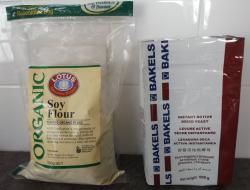 Daphnia food, soy flour and activated baker's yeast
Daphnia food, soy flour and activated baker's yeastDaphnia feed on green water and protozoa. A large culture can clear a pond of green water overnight, so it is impractical to find enough green water over a long period of time. Other food options have to be found.
The most common food options are:
- Green water (when available)
- Yeast
- Soy flour
- Wheat flour
- Infusoria
- Dried blood
- Spirulina
- A combination of the above.
My cultures are very rarely fed green water. I prepare a mixture of activated yeast and soy flour. (You can just use yeast, but my cultures seem to have gotten thicker since adding the soy flour. This may be due simply to the increased food quantity).
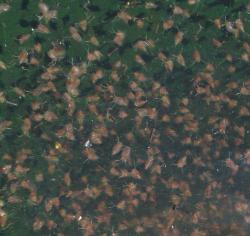 Thriving Daphnia culture
Thriving Daphnia cultureI mix approximately 1.5 grams of yeast with 1.5 grams of soy flour. I mix this in a glass of warm water. (The warm water activates the yeast).
Once the mixture is fully dissolved in the water, I pour it into a two liter container, stirring to stop the mixture from settling. I pour the mixture evenly around the culture.
This feeds one established 80 gallon culture.
The rule is underfeed rather than overfeed. You can always increase the feeding and watch the result. The daphnia numbers should increase if you have been underfeeding. The amount I am feeding produces huge numbers of daphnia.
During summer and the warmer months, I feed my cultures daily. When the weather gets cooler I cut feeding back to every two then every three days. The water should have cleared before you feed the culture again. If it hasn’t you are overfeeding.
You will need to scale up or down your feeding based on my quantities for 80 gallons. For example:
- 40 gallon container 40/80=0.50. Multiply 1.5 grams by 0.5=0.75 grams
- 150 gallon container 150/80=1.88. Multiply 1.5 grams by 1.88=2.82 grams.
Some professional fish breeders feed enough food to their cultures to last several days.
Gentle aeration is used to keep the food suspended in the water, otherwise, it would settle on the bottom. They feed again when the water clears.
Tip:
When aerating daphnia cultures, make sure it is very gentle, and the bubbles are coarse.
If the bubbles are too fine, they tend to get caught in the shell of the daphnia forcing them up to the surface where they get trapped in the surface tension and die.
I have found large numbers of daphnia tend to create their own currents as they gather in large groups, usually where sun strikes the pond.
I prefer the daily feeding method (during the warmer months), as my cultures appear far thicker than those that are fed larger amounts of food less frequently. A lot of the food probably sinks to the bottom before it is eaten despite the aeration.
Culture Problems
Daphnia will die off if conditions are not good, and then magically reappear when conditions improve.
A good indication that a culture is healthy is if there are daphnia of all ages present. If a culture is struggling, you will find that there are no larvae or juveniles, they are all adults.
If a culture suddenly dies off, test the water to see what caused it. Usually, it is poor water conditions caused by overfeeding.
Don’t clean out the culture container unless another daphnia source is available. Change the water but don’t remove all the debris on the bottom as it will contain dormant eggs. Let the water turn green and re-seed with more daphnia or wait until the dormant eggs hatch.
You will notice the water starting to clear again indicating the culture has regenerated.
Treat daphnia like any other aquatic animal regarding pH and water conditions. Keep the pH around 7.
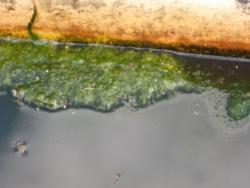 Blanket weed in daphnia pond
Blanket weed in daphnia pondBlanket weed can take over a culture pond if it isn’t controlled. A daphnia culture is an ideal environment for it to flourish with clear water and nutrients being added continuously by the daphnia.
Blanket weed is usually a symptom of too much light. Shade the culture with shade cloth or move it to a more shaded position.
Mosquitoes can be a real problem if they become established. Mosquito wrigglers feed on the same food you are feeding the daphnia. Mosquitoes seem to sense a pond full of daphnia will be a safe environment for their young.
Mosquito wrigglers are an ideal food for goldfish if you can harvest them with the daphnia before they pupate into adults.
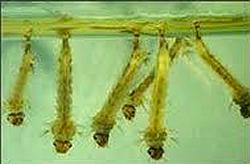 Mosquito wrigglers can become a problem in daphnia cultures if left unchecked.
Mosquito wrigglers can become a problem in daphnia cultures if left unchecked.The easiest control method is to cover the culture with fine netting and remove any eggs as you see them. The netting would also keep other flying insects out such as dragonflies that pose a threat to young goldfish.
Always keep several cultures going in case one dies off suddenly. A culture can be quite small. I keep one in a one-quart jar inside the house.
